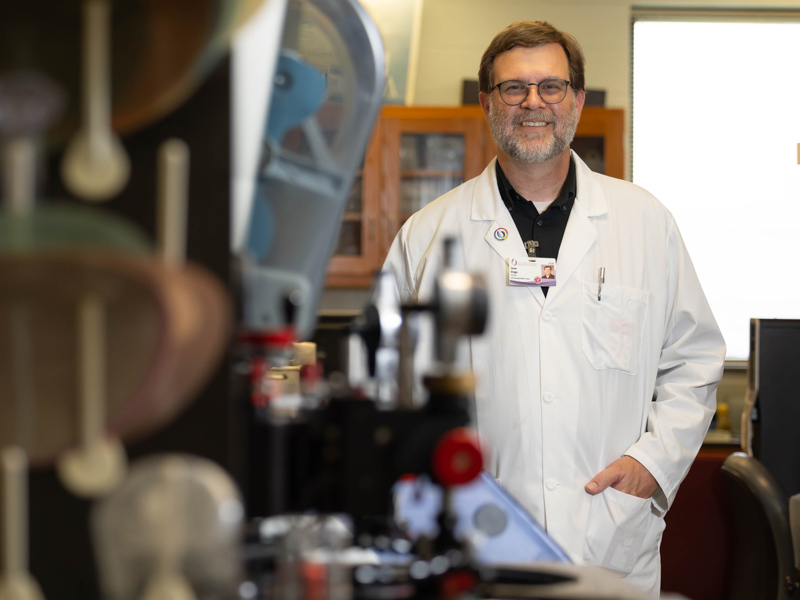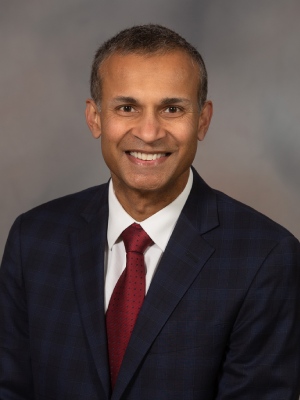Griggs recognized for decades of dental materials research

Decades of research by Dr. Jason Griggs give him the expertise to select and manipulate chemicals and materials to produce dental care must-haves – for example, crowns or the fillings for cavities that patients trust won’t break or easily wear out.
“One of the most common situations a patient will find themselves in is that they have a diseased part of a tooth, and the dentist needs to use a drill to remove the decayed area,” said Griggs, an internationally respected dental materials researcher and associate dean for research in the School of Dentistry at the University of Mississippi Medical Center.
“That forms a cavity that needs to be filled. Usually, the dentist fills it with materials that are mixed together with separate components,” Griggs said. “The dentist is always doing some type of chemistry chairside.”
Griggs, professor and former chair of the SOD’s Department of Biomedical Materials Science, has made dental materials research his life’s work. It’s a passion that he instills in his student researchers as they work together to make dentistry more practical, effective and affordable to patients.
His thirst for knowledge and dedication to educating the next generation has been recognized by the International Association of Dental Researchers (IADR) with its Wilmer Souder Award.
It honors Dr. Wilmer Souder, the motivating force in establishing the Dental Section at the National Bureau of Standards, now the National Institute of Standards and Technology. The honor is designed to perpetuate the scientific ideals he exemplified and encourage interest in dental materials research. It’s considered the highest honor in the field for scientists who bring about outstanding advances in dental health.

Griggs is richly deserving, said Dr. Sreenivas Koka, dean of the School of Dentistry and professor in the Department of Care Planning and Restorative Sciences.
“When I travel the world and say I am from Mississippi, in academic circles, Jason is, by far, the most common person to whom I am asked to say hello,” Koka said. “People light up at the mention of his name. His global reputation is very strong, not just as an impeccable scientist, but as the humblest of human beings.”
“While the quantity and quality of his research publications, the number of students he has mentored, or the number of times he has been invited to speak about his research at national and international conferences is quite impressive, I believe they do not tell the whole story of Dr. Griggs’ true impact on our chosen profession and on our institution,” said Dr. Amol Janorkar, professor and chair of Biomedical Materials Science.
Griggs’ path to dental materials research evolved through mentorship by world-class scientists at the University of Florida. “I knew that I was interested in designing new and improved types of chemicals, and molecular arrangements to make materials with better properties,” he said.
“I assumed incorrectly that it would be a chemical engineer who would design new chemicals. Turns out that chemical engineers design factories. I found that a materials engineer designs new chemicals.”
Griggs had the privilege of working in that university’s Department of Materials Science and Engineering with Dr. Larry Hench, the inventor of Bioglass, the first synthesized material that interacts with the body to initiate healing. Hench’s breakthrough led to commercial applications for bone repair, dental restoration, dentin-sealing toothpaste and other oral health care improvements.
Griggs asked Hench if he could have a summer job with his Bioglass company. “He said that he only hires people who already have their PhDs, and that working 60-plus hours a week isn’t suitable for an undergrad,” Griggs remembered. “But, he said he had another company with a contract to make lasers for the Star Wars defense grid.”
Also known as the Strategic Defense Initiative, or SDI, it referenced a proposed U.S. strategic defensive system against potential nuclear attacks from the Soviet Union.
Griggs had to earn his way there. He took a class from Hench, and at the end of the course, Hench asked for a student volunteer to write a program to automatically calculate a recipe for the composition of any glass.
“After I turned it in, he said, ‘You’re hired,’” Griggs remembered. “And then, Congress canceled the Star Wars defense grid program.”
But fortunately, two other world-renowned biomaterials researchers (Dr. Ken Anusavice and Dr. Jack Mecholsky) worked on the same campus, and Hench asked them to hire Griggs and his other students to work in the School of Dentistry.
“That’s how I got into dental materials. I saw two things: that it felt better to design materials that were healing people instead of being used in warfare, and that research funding in the health sciences was much more consistent than research funding in the military.”
Griggs earned his bachelor’s, master’s and doctoral degrees in materials science and engineering from the University of Florida
“My bachelor’s degree required a thesis, and mine looked at possible errors a dentist can make in mixing tooth-colored filling materials chairside and conducting a chemical reaction,” Griggs said. “Some of the materials back then were less user-friendly and involved mixing liquids with powders. You had to fluff the powder in a cannister, and use an eye dropper with the liquids.”
It’s exercises like that, Griggs said, that directly impact patient care and student education.
“Since then, I’ve concentrated on how materials degrade over time and on designing tests to determine how long materials will last in the human body,” he said. “I’ve been working on titanium dental implants and how they fail, polymer-based denture teeth and how they sometimes chip, tests to reproduce the chipping, and designing better denture teeth that are more resistant to chipping.
“Another area of materials research is to try to invent new materials that are less expensive so that patients who don’t have dental insurance, or who have lesser means to pay for dental care, can benefit from it,” Griggs said.

Griggs has paid it forward as a mentor to many, including Dr. Kartikeya Jodha, who began studying with Griggs in 2016 as a graduate student in biomedical materials science.
“I think he’s the main driver of what I am now, and how I see this field,” said Jodha, a postdoctoral fellow. “Oral health isn’t just oral health. It affects your entire system, so it’s all the more important to maintain good oral hygiene and oral health.”
Griggs has been a day-to-day influence in Jodha’s development as a scientist. “He is always trying to build that humility in me so that I can talk to other people, be open, learn from them, and at the same time, use that in my research,” Jodha said.
“He gives me pointers and puts the positive first, and then he tells me what I can improve upon. He has helped me grow, and I can see him mentoring me my entire life. He is so approachable, and his door is always open.”
“I can honestly say that the reality of working alongside Jason far exceeds his reputation. He is unlike anyone else I have ever met,” Koka said. “As we work towards a kinder and collaborative work environment in our School of Dentistry, Jason stands out as representing our best attributes. It is a privilege to be his colleague and friend.”


